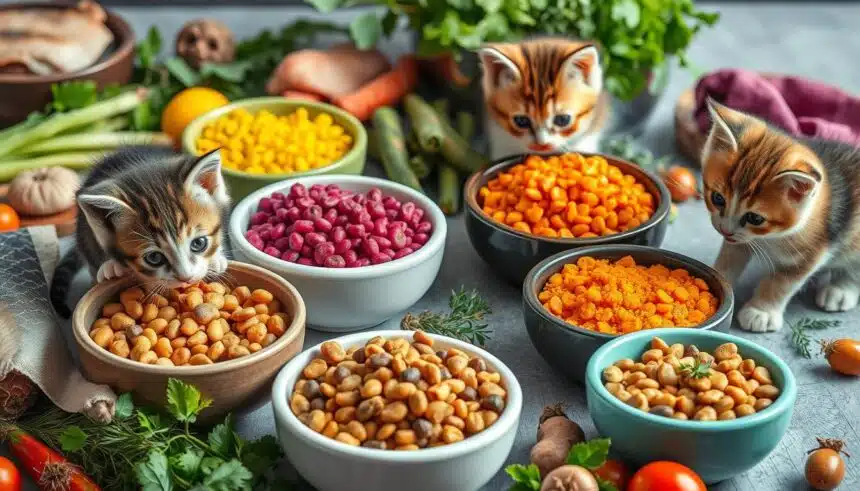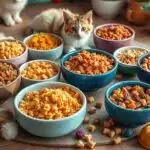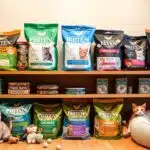As a cat owner, giving your kitten the right food is key for their health. Wet kitten food is full of moisture, which helps keep their kidneys and bladder healthy. It’s made with meat, making it a great choice for a balanced diet.
Kitten nutrition is very important for their health. Wet food helps make sure they get all the nutrients they need.
Wet kitten food has many benefits. It’s easy for kittens to digest and helps their immune system work well. Vets say to feed it twice a day, in amounts that fit their size.
Many cat owners have seen their picky eaters love high-quality wet food. The right wet kitten food gives your pet the nutrients they need for a happy, healthy life.
Key Takeaways
- Wet kitten food provides optimal moisture content for renal and urinary health.
- High-quality meat sources in wet food increase acceptance among finicky eaters.
- Wet food offers seamless digestion and a well-functioning immune system.
- Kitten nutrition is critical for growth and development.
- Wet kitten food benefits include a reduced risk of dehydration and digestive issues.
- Feeding wet food twice a day in suitable portions is recommended by vets.
Understanding Wet Kitten Food
Wet kitten food is made from high-quality protein like chicken or salmon. It also has important vitamins and minerals. It’s very moist, which helps keep your kitten hydrated and healthy. When looking at wet vs dry kitten food, knowing the benefits of each is key.
The best wet cat food has about 75-78% moisture. This helps keep pets hydrated and can prevent urinary tract diseases. Brands like Feline Natural and K9 Natural use 90-99% whole food ingredients, which is great for kittens.
Definition and Composition
Wet kitten food is made from top-notch protein sources and has essential vitamins and minerals. Its soft texture is good for pets after dental work. It also makes food more appealing, especially for pets that are sick or recovering.
Nutritional Value
Wet kitten food has fewer calories than dry food, which helps with weight control. Its high water content helps prevent urinary tract diseases and supports kidney health. When picking the best wet cat food, think about your pet’s taste, health needs, and your lifestyle. Regular vet visits for dental care are still important, no matter the food choice.
The Benefits of Moisture in Diet
Moisture is key in a kitten’s diet, and wet food for cats is a great source of water. It’s vital for preventing urinary tract problems and keeping kittens healthy.
Feeding kittens wet food for cats helps them drink more water than they would with dry food or water alone. Cats need about 20-30 ml of water per kg of body weight each day.
- Preventing urinary tract issues, such as bladder stones, which occur in around 2% of cats
- Supporting overall health, including muscle health and maintaining lean body mass
- Providing essential nutrients, such as iron, zinc, and biotin, crucial for overall health
In conclusion, the role of moisture in a kitten’s diet is clear. wet food for cats is a great way to ensure kittens get enough water to stay healthy.
Rich Source of Protein
Wet kitten food is packed with protein, which is key for a kitten’s growth. Kittens need a lot of protein to stay healthy, including kitten digestive health. Without enough protein, kittens might lose their appetite, lose weight, and feel tired.
The American Association of Feed Control says cat food should have at least 26% to 30% protein. Wet kitten food has more animal-based protein than dry food. This meets cats’ needs as meat-eaters. The wet kitten food benefits include many protein-rich recipes and textures that cats love.
Role of Protein in Growth
Protein is crucial for a kitten’s growth. It helps build muscles, bones, and organs. A protein-rich diet is key for kittens to grow strong and healthy.
How It Supports Muscle Development
Wet kitten food is full of protein, which is great for muscle growth. The high-quality protein in wet food helps kittens build and repair muscles. This ensures they grow strong and healthy. Wet kitten food is also good for kitten digestive health, making it a great choice for kitten owners.
| Protein Source | Percentage of Protein |
|---|---|
| Chicken | 70-80% |
| Turkey | 70-80% |
| Beef | 60-70% |
Enhanced Palatability for Fussy Eaters
Wet kitten food is very tasty and comes in many flavors. This makes it perfect for picky eaters. Experts say the best wet cat food should have 70-90% moisture. This helps kittens drink more water, which is key for their health.
Wet kitten food is full of protein, just like what cats used to eat. It has 10-13% protein, giving kittens the amino acids they need to grow. It also has 2-10% fat, which keeps their skin and fur healthy.
Choosing the right wet food is important for kittens and adult cats. Kittens need more food to grow fast, while adults need less. The best wet cat food ensures fussy eaters get the nutrients they need.
Flavor Varieties Available
There are many flavors of wet food, like chicken, duck, and salmon. These flavors can make picky eaters happy. By trying different flavors, you can find the perfect food for your kitten’s taste.
Supporting Healthy Digestive Systems
Wet kitten food is easier to digest than dry food. This is great for kittens, as they often have digestive problems. The wet kitten food benefits include more protein and less carbs. This makes it perfect for kittens with sensitive stomachs.
The wet kitten food benefits also help prevent digestive issues. It provides more moisture, which helps prevent dehydration and urinary tract infections. Plus, its high protein supports kittens’ growth and development.
Some key benefits of wet kitten food for kitten digestive health are:
- Easier to digest than dry food
- Higher protein content
- Lower carbohydrates
- More natural source of moisture
Wet kitten food is a top choice for kittens’ digestive health. It has more protein, less carbs, and natural moisture. These features help prevent digestive problems and support kittens’ overall health.
| Food Type | Moisture Content | Protein Content |
|---|---|---|
| Wet Kitten Food | 70-80% | 30-40% |
| Dry Kitten Food | 5-10% | 20-30% |
Essential Vitamins and Minerals
Wet kitten food is packed with vitamins and minerals that kittens need to grow. It’s key for their nutrition. Cats need at least 12 essential vitamins, like A, D, and E, for their body to work right.
Feeding kittens a diet that meets all their nutritional needs is important. Wet kitten food has lots of water, which is great for keeping them hydrated. It also has important minerals like iron and calcium. Iron fights anemia, and calcium helps bones grow strong.
- Vitamin A for a strong immune system and healthy vision
- Vitamin D for calcium and phosphorus balance
- Essential minerals like iron, calcium, and magnesium
For a kitten’s health, a balanced diet is crucial. Wet kitten food gives them the vitamins and minerals they need. This helps them grow strong and healthy, ready to be adult cats.
Weight Management and Control
Wet kitten food is great for keeping kittens at a healthy weight. This is key to avoid obesity, which can cause diabetes, joint problems, and even death. Studies show that obese cats are nearly three times more likely to die than those at a healthy weight.
Wet food helps with weight control because it’s full of water and has fewer calories than dry food. It’s important to watch a kitten’s weight and adjust their food portions. A 15-pound cat should lose 1-2% of its body weight each week. This means losing about 3 ounces a week.
Here are some tips for managing a kitten’s weight with wet food:
- Feed 3-4 meals a day for kittens, as they have high energy requirements
- Choose a high-protein, low-carbohydrate wet food to reduce hunger and support weight loss
- Monitor food portions and adjust as needed to prevent overeating
By using these tips and adding wet kitten food to their diet, owners can help kittens stay healthy and avoid obesity. Remember, kitten nutrition is vital for their health and growth. Wet kitten food is a great way to keep them at a healthy weight.
| Age | Feeding Frequency | Food Amount |
|---|---|---|
| Kittens (0-1 year) | 3-4 meals a day | 4-6 ounces of canned food per day |
| Adult cats | 2 meals a day | 2-4 ounces of canned food per day |
Transitioning from Dry to Wet Food
Switching from dry to wet food for kittens or adult cats needs careful planning. Wet and dry foods have different nutrients. A slow switch can avoid stomach problems.
It’s important to watch how the kitten reacts to the new food. Look for changes in poop, how often they go, and its color. Also, feed them on a schedule to avoid overeating and keep them at a healthy weight.
Tips for a Smooth Change
- Start by mixing a small amount of wet food with the kitten’s regular dry food
- Gradually increase the proportion of wet food over a period of 7-10 days
- Monitor the kitten’s response and adjust the transition period as needed
By following these tips and watching the kitten closely, the switch can go well. Remember, every kitten is unique. Tailor the transition to fit their needs. With patience and careful watching, kittens can do great on wet food.
Cost Considerations of Wet Kitten Food
Choosing between wet and dry kitten food often comes down to cost. Wet food is pricier because it’s more moist and comes in different packaging. Yet, the long-term health benefits of wet kitten food can save you money on vet bills.
Looking at prices, feeding a ten-pound cat wet food-only costs $1.22 to $5.77 daily. Dry food, on the other hand, costs $0.23 to $0.97 daily. Even though wet food is more expensive upfront, its health perks might be worth it.
Here’s a look at the costs and benefits of wet and dry kitten food:
| Type of Food | Cost per Day | Moisture Content | Potential Health Benefits |
|---|---|---|---|
| Wet Kitten Food | $1.22 – $5.77 | 70-85% | Improved digestion, reduced risk of urinary tract issues |
| Dry Kitten Food | $0.23 – $0.97 | 6-10% | Convenient, cost-effective, but may contribute to obesity and other health issues |
In summary, even though wet kitten food costs more than dry, its health benefits are significant. By weighing the wet kitten food benefits against your kitten’s needs, you can choose the best food for them.
Best Practices for Feeding Wet Kitten Food
Feeding wet kitten food can be very good for kittens. It helps them stay hydrated and taste better. To get the most out of it, follow some key feeding tips.
Kittens need the right food to grow well. A balanced diet with wet food is key. Feed them three to four times a day for the first six to nine months. Then, switch to twice a day by their first birthday.
Here are some important feeding tips for wet kitten food:
- Provide 1 to 2 cups of fresh water every day.
- Give 1/3 to 1/2 of a 5-oz. can of wet cat food per meal.
- Keep a regular feeding schedule to help them grow.
By following these tips, you can help your kitten stay healthy. This way, you’ll enjoy the benefits of wet kitten food and good nutrition.
Popular Brands of Wet Kitten Food
Choosing the best wet cat food for your kitten is important. Several brands offer high-quality ingredients and nutrition. These brands focus on providing a balanced diet for kittens, supporting their growth and development.
Purina Pro Plan, Hill’s Science Diet, and Royal Canin are among the top brands. They offer a variety of flavors and textures. This includes minced, pâté, and chunks in gravy. They also provide a balanced mix of protein, fat, and carbohydrates, along with essential vitamins and minerals.
Look for protein as the first ingredient in brand ingredients. Also, check for omega-3 fatty acids for growth and brain development. Moisture content is key, with at least 75% recommended. Some popular brands include:
- Purina Pro Plan: Offers a range of flavors and textures, with 80% moisture content and 25 essential vitamins and minerals.
- Hill’s Science Diet: Formulated to support weight management and overall health, with 84% moisture content and a balanced mix of protein, fat, and carbohydrates.
- Royal Canin: Provides a range of flavors and textures, with 82.5% moisture content and a focus on digestive health.
Choosing a high-quality brand of wet kitten food supports your kitten’s health and well-being. Look for brands with a balanced diet, protein as the first ingredient, and enough omega-3 fatty acids and moisture. With the right nutrition, your kitten can thrive and grow into a healthy adult cat. You’ll know you’re providing the best wet food for cats.
| Brand | Moisture Content | Protein Content | Calories per Can |
|---|---|---|---|
| Purina Pro Plan | 80% | 30-40% | 72-73 calories per 3 oz. can |
| Hill’s Science Diet | 84% | 30-40% | 62-72 calories per 2.9 oz. can |
| Royal Canin | 82.5% | 30-40% | 67 calories per 3 oz. can |
Common Misconceptions About Wet Food
There are many myths about kitten nutrition when it comes to wet kitten food. One big plus is its high moisture, which helps keep the urinary tract healthy. Yet, some think dry food is better for a kitten’s teeth, which isn’t true.
Research shows dry food doesn’t really help with dental health. For good oral health, regular dental cleanings and daily brushing are key. Cats need certain nutrients found mainly in animal tissues. So, a balanced kitten nutrition plan is vital for their health.
Some think wet food is less convenient or more expensive than dry food. But, many find the benefits of wet food, like its moisture and taste, are worth it. Knowing the truth about wet kitten food and kitten nutrition helps pet owners make better choices for their kitten’s health.
- High moisture content supports urinary tract health
- Regular professional dental cleanings and daily toothbrushing are more effective for maintaining good oral health
- A balanced and complete kitten nutrition plan is crucial for overall health
Conclusion: Is Wet Kitten Food Right for Your Pet?
Choosing between wet and dry food for your kitten is crucial. Wet kitten food has many benefits. It keeps your kitten hydrated, has more protein, and tastes better to picky eaters.
Knowing the nutritional value and health benefits helps you make the right choice. This choice supports your kitten’s growth and health.
Deciding on wet kitten food depends on your kitten’s needs and what your vet says. Wet food is rich in moisture and nutrients. It helps with hydration, muscle growth, and health.
When choosing, aim for a diet that fits your kitten’s specific needs. This ensures they get the best nutrition.
FAQ
What is wet kitten food and what are its benefits?
Wet kitten food is made from high-quality protein sources like chicken or salmon. It also has essential vitamins and minerals. This food is rich in moisture, which helps keep your kitten hydrated and supports their health.
Why is moisture important in a kitten’s diet?
Moisture is key in a kitten’s diet. Wet kitten food is a great source of hydration. It helps prevent urinary tract issues and supports overall health.
How does wet kitten food provide protein and support muscle development?
Protein is crucial for kittens, and wet kitten food is a top source. It helps with muscle growth and development.
What makes wet kitten food attractive to fussy eaters?
Wet kitten food is very tasty and comes in many flavors. This makes it perfect for fussy eaters. Its taste and variety encourage natural feeding behavior.
How does wet kitten food support healthy digestion?
Wet kitten food is easier to digest than dry food. It supports a healthy digestive system. It also improves gut health.
What essential nutrients does wet kitten food provide?
Wet kitten food has all the vitamins and minerals kittens need. It provides the necessary nutrients for optimal health.
How can wet kitten food help with weight management and control?
Wet kitten food helps manage and control weight. It prevents obesity. Proper portion sizes and monitoring are key for a healthy weight.
How can I smoothly transition my kitten from dry to wet food?
Transitioning to wet food can be smooth with the right tips. It’s important to watch your kitten’s response and make adjustments as needed.
Is wet kitten food more expensive than dry food, and is it worth the investment?
Wet kitten food might cost more than dry food. But it’s a long-term investment in your kitten’s health. The benefits of wet food are worth it for your kitten’s health and development.
What are the best practices for feeding wet kitten food?
Following best practices for feeding wet kitten food is crucial. This includes recommended feeding schedules and keeping food fresh. These practices support your kitten’s health.
What are some popular brands of wet kitten food to consider?
Many popular brands offer high-quality wet kitten food. When choosing, look at the ingredients and how they support your kitten’s health.
What are some common misconceptions about wet kitten food that need to be debunked?
There are many misconceptions about wet food. It’s important to know the facts and understand the science behind its benefits.




